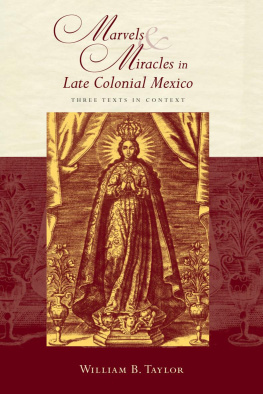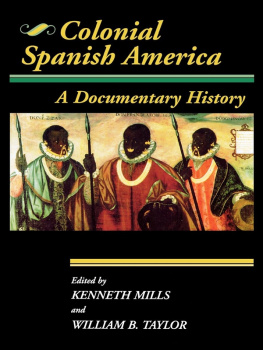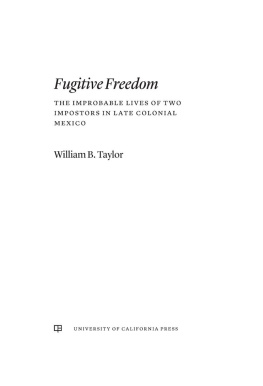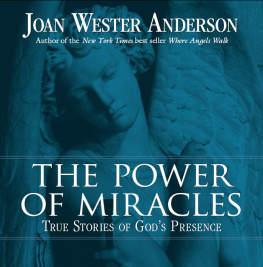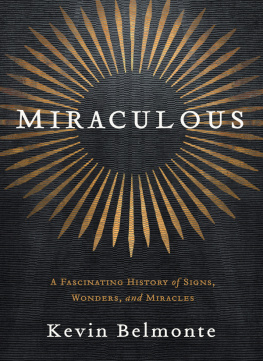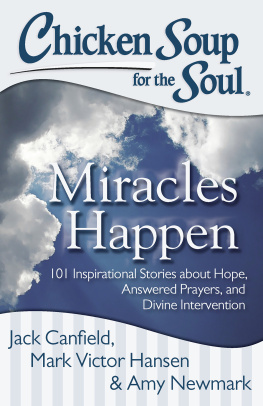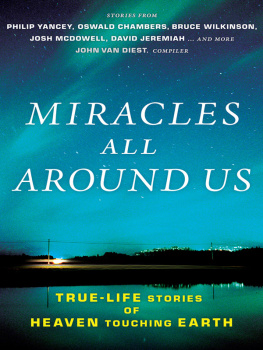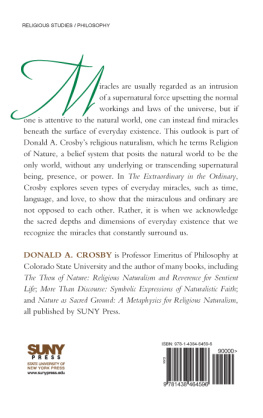MARVELS AND MIRACLES IN
LATE COLONIAL MEXICO
A Volume in the
RELIGIONS OF THE AMERICAS SERIES
Sacred Spaces and Religious Traditions in Oriente Cuba
by Jualynne E. Dodson
Louis Riel and the Creation of Modern Canada: Mythic Discourse and the Postcolonial State
by Jennifer Reid
Strange Jeremiahs: Civil Religion and the Literary Imaginations of Jonathan Edwards, Herman Melville, and W. E. B. Du Bois
by Carole Lynn Stewart
Shrines and Miraculous Images: Religious Life in Mexico Before the Reforma
by William B. Taylor
Editors: DAVD CARRASCO AND CHARLES H. LONG
M arvels & M iracles in
Late Colonial Mexico
THREE TEXTS IN CONTEXT
William B. Taylor
2011 by the University of New Mexico Press
All rights reserved. Published 2011
Printed in the United States of America
16 15 14 13 12 111 2 3 4 5 6
ISBN for this digital edition: 978-0-8263-4977-4
The Library of Congress has catalogued the printed edition as follows:
Taylor, William B.
Marvels and miracles in late colonial Mexico:
three texts in context / William B. Taylor.
p. cm. (Religions of the Americas)
Includes bibliographical references and index.
ISBN 978-0-8263-4975-0 (cloth : alk. paper)
1. MiraclesMexicoEarly works to 1800.
2. MexicoChurch history18th centurySources.
I. Title.
II. Title: Trouble with miracles.
III. Title: Our lady in the kernel of corn.
IV. Title: Between Nativitas and Mexico City.
BT97.3.T39 2011
232.91'70972dc22
2010040720
CONTENTS
: Summary investigation concerning the marvel that Our Lady of the Walnut Tree worked for Doa Mara Francisca Larralde, wife of Sergeant Major Don Antonio Urresti, residents of this city of Monterrey, witnessed and written down by Joseph Ygnacio Trevio, notary public of this aforementioned city (1758)
: Account of the prodigious miracle by Most Holy Mary in the village of Santa Mara de la Asumpcin Tlamacazapa, parish of Acamixtla, appearing as the figure of Divine Grace in a kernel of corn to an Indian woman about to give birth (1774)
: History of Miracles Worked by the Image of Our Lady of Intercession which is Venerated in the Monastery of Nativitas of Tepetlatzinco Pueblo, by Fray Francisco de la Rosa Figueroa (1776)
FOREWORD
With the publication of Marvels and Miracles in Late Colonial Mexico: Three Texts in Context, our Religions of the Americas series offers an innovation to benefit readers who want to go more deeply into the history of religion in Mexico. This sourcebook is a companion volume to William B. Taylors Shrines and Miraculous Images: Religious Life in Mexico Before the Reforma and consists of three substantial, largely ignored documents about miracles and shrines in late colonial Mexico, plus introductory essays on faith practices and colonial politics. It provides for students of colonial Mexico important primary sources and invites them to enter more vigorously into dialogues about historical understandings of religious devotion and practice in Mexico. The three documents, in Taylors words, help us glimpse news of miracles in their first, unfinished stagesmore singular and idiosyncratic in ways that restore some rough edges, personalities, and contingencies to the compressed, authorized miracle stories. Taylor views historical writing as, in part, a restless kind of discipline of context, and readers of this book will benefit from his disciplined work on the sensual faith of Catholic Christianity and the ways this sensual faith was transmitted, received, and reworked by people in various social and political positions. Through Taylors dexterous ways of handling these documents, we are able to move closer to what was considered crucial to the personal and collective well-being of Mexico and Mexicans. We hope that this innovation of combining primary documents with interpretive essays in a single volume will lead to other skillful advances in scholarship on the many religious practices and traditions in this part of the Americas.
Davd Carrasco
Harvard University
ACKNOWLEDGMENTS
Special thanks to my students and coteachers in History 8A and 140A at the University of California, Berkeley, who worked through these and other primary sources with me.
I am indebted to the Fondo Reservado of the Biblioteca Nacional de Mxico on the campus of the Universidad Nacional Autnoma de Mxico for permission to publish my translation of History of Miracles Worked by the Image of Our Lady of Intercession which is Venerated in the Monastery of Nativitas and the accompanying print; to the Bancroft Library for permission to include my translation of Summary investigation concerning the marvel that Our Lady of the Walnut Tree; to The Americas: A Quarterly Review of Inter-American Cultural History for permission to republish Our Lady in the Kernel of Corn from vol. 59:4 (April 2003), pp. 55970; to the University of New Mexico Press for Between Nativitas and Mexico City: Miracles and the Mundane in an Eighteenth-Century Pastors Local Religion, which first appeared in Martin Nesvig, ed., Local Religion in Colonial Mexico (Albuquerque: University of New Mexico Press, 2006), pp. 91117; and to Koninklijke Brill N.V. for permission to include Trouble with Miracles: An Episode in the Culture and Politics of Wonder in Colonial Mexico, from Christopher Ocker, Michael Printy, Peter Starenko, and Peter G. Wallace, eds., Politics and Reformations: Communities, Polities, Nations, and Empires. Essays in Honor of Thomas A. Brady, Jr. (Leiden: Brill, 2007), vol. 1, pp. 44158.
INTRODUCTION
The readings in this little book consist of three unusual documents about miracles in late colonial Mexico paired with an introductory essay. The documents date from the second half of the eighteenth century when Spains Bourbon dynasty sought to tighten its control over the New World colonies in ways meant to reform imperial institutions and change the role of the church and religion in colonial life. As the essays suggest, these documents bear on colonial politics and society, as well as faith in practice; and each one is rich and ambiguous enough to include distinctive voices and open complex episodes that invite more than one line of inquiry without final answers.
Miraclesthose signs of divine presence and intervention in the world that defy ordinary experience of cause and effecthave been esteemed by Christians, especially Catholic Christians, as a central belief and treated as allegories of salvation. Christian shrines are almost always miracle shrines, and miracles became one more proof that our religion is a living one, as Mexican Jesuit Francisco de Florencia put it near the end of the seventeenth century. While God was believed to have unlimited power to work wonders in the world, miracles were recognized and publicized sparingly by the church hierarchy during Mexicos colonial period. Miracle was a loaded word, with juridical meaningonly a bishops court could say whether a portentous occurrence truly was a miracle. The colonial courts usually were silent on the matter, then increasingly reluctant to recognize miracles during the late eighteenth century when the three documents in this book were composed.
After the Council of Trent (15451563), Catholic leaders were inclined to regard Christs displays of wonder working in the New Testament as the necessary cornerstones of Christianitys beginning rather than the first of countless miracles to come. Their view was that miracles were still possible, but less common, both because the true Church was established and because the faith of most Christians had cooled and no longer invited personal intervention. Or, if supernatural events did occur, they were likely to be the work of the devil, leading the morally weak astray and endangering their immortal souls. By the eighteenth century, more direct documentation of miraculous events was expected and many colonial officials took a more skeptical stance, often dismissing the growing number of reported wonders as overripe fruit of popular ignorance and superstition or mendacity. With or without official encouragement, news of amazing healings, rescues, and acts of divine retribution broke and surged like ocean waves on a rising or ebbing tide throughout Mexicos long colonial period among all kinds of people, but believers learned that it was best to speak of

